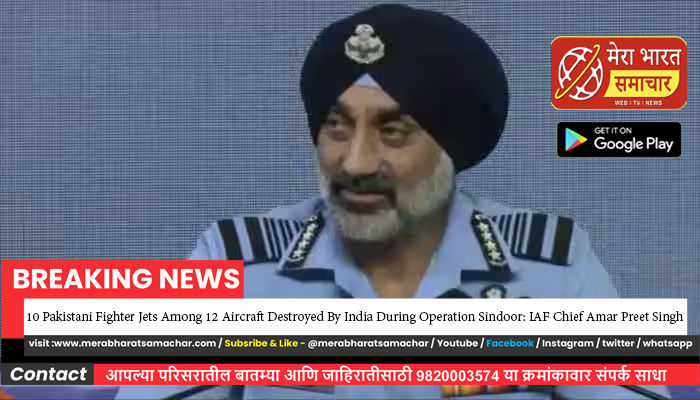
10 Pakistani Fighter Jets Among 12 Aircraft Destroyed By India During Operation Sindoor: IAF Chief Amar Preet Singh
Indian Air Chief Marshal Amar Preet Singh on Friday revealed that Pakistan sought a ceasefire during Operation Sindoor, emphasising that the halt in hostilities on May 10 came as a result of Islamabad’s request for peace. He also described the operation as a decisive action with a clear objective. Air Chief Marshal said India destroyed around 12 Pakistani aircraft during operation Sindoor, of which 9-10 were fighter jets.
Speaking about the operation, Air Chief Marshal Singh highlighted the clarity of the directive and the swift conclusion. "This is one war that was started with a very clear objective and was terminated quickly, without prolonging it. In contrast to ongoing conflicts around the world, where hostilities drag on, we managed to bring the adversary to a stage where they asked for a ceasefire and the termination of hostilities. As a nation, we also decided to end those hostilities once our objectives were achieved. This is a lesson the world should learn from us."
"A firm mandate was given to the Indian Armed Forces, and we took the operation to a point where they ultimately called for a ceasefire," he stated.
Responding to a question on the losses suffered by Pakistan during Operation Sindoor, Indian Air Force Chief Air Chief Marshal AP Singh says, "...As far as Pakistan's losses are concerned...we have struck a large number of their airfields and we struck a large number of installations...Because of these strikes, radars at least four places, command and control centres at two places, runways of course damaged at two places, then three of their hangars in three different stations have been damaged..."
Speaking further, he added that 4 to 5 fighter aircraft, most likely F-16 of Pakistan, were destroyed during Operation Sindoor. "We have signs of one C-130 class of aircraft...and at least 4 to 5 fighter aircraft, most likely F-16, because that place happened to be F-16 with whatever was under maintenance at that time. Along with that, one SAM system has been destroyed...We have clear evidence of one long-range strike, which I talked about more than 300 km, which happened to be either an AEW&C or a SIGINT aircraft, along with five high-tech fighters between the F-16 and JF-17 classes. This is what our system tells us."
The Air Chief Marshal emphasised the significant role played by the robust air defence infrastructure in the success of the mission. "We were able to penetrate deep into enemy territory, executing strikes with high precision using long-range weapons. The operation achieved the longest-range kill to date."
Speaking further he said, "...Our long-range SAMs that we had procured recently and operationalised...We could look deep inside their territory. We could make sure that they were not able to operate even within their territory up to a certain distance. It will go down in history the longest kill that we achieved of more than 300 kilometres by that. And it seriously curtailed their activities."
Satellite imagery confirmed the effectiveness of the strikes, he added. "Pakistan was unable to operate even within its own territory during the operation."
Air Marshal Singh noted that Operation Sindoor brought the importance of air power to the forefront. He revealed ongoing efforts to develop India’s own air defence system, Sudarshan Chakra, akin to the Iron Dome. "There is an urgent need for Atmanirbharta; we cannot remain dependent," he stressed.
The Air Chief Marshal reminded that the nature of warfare is constantly evolving. "The next conflict will not resemble the last. We must be prepared for the future."
www.merabharatsamachar.com
